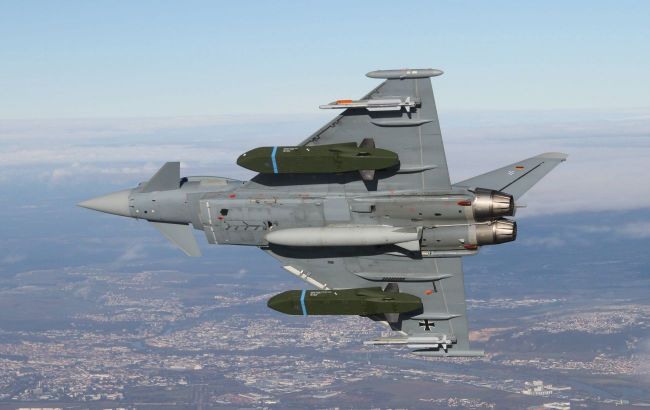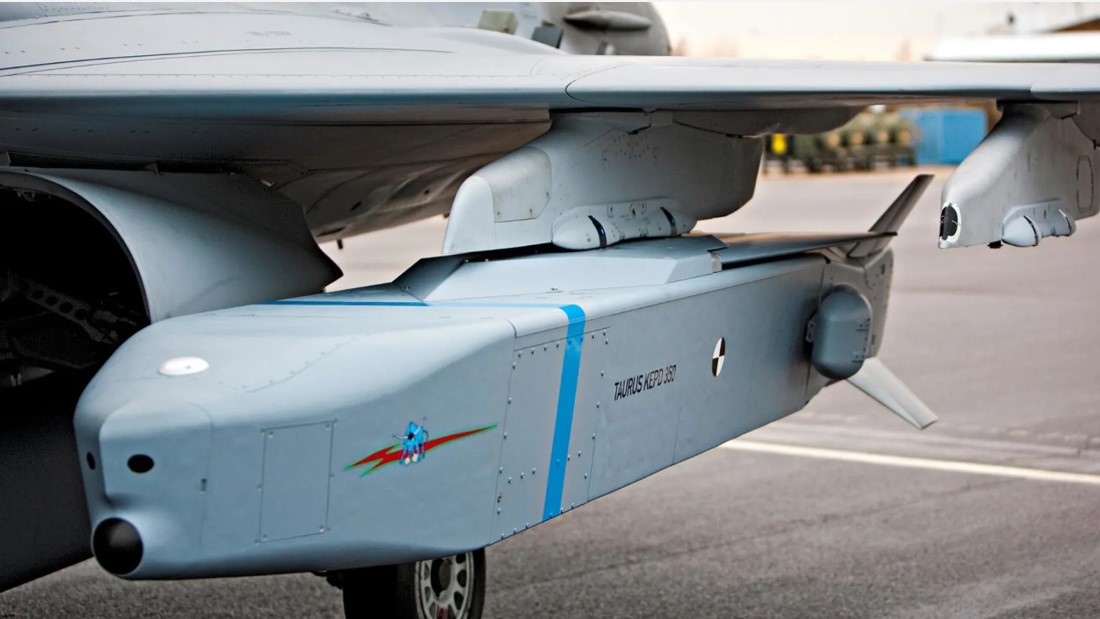Key to liberating Crimea: Ukraine's need for Taurus missiles and Scholz's supply dilemma
 Eurofighter aircraft with Taurus missiles (Photo: mbda-deutschland.de)
Eurofighter aircraft with Taurus missiles (Photo: mbda-deutschland.de)
Ukraine has been seeking deliveries of long-range Taurus missiles for several months. However, Germany refused for various reasons, either fearing strikes on Russian territory or stating that deployment would require the participation of German military personnel.
About the stage of the process, the characteristics of Taurus, what the transfer of missiles depends on, and whether our Air Force can receive them at all - in the material of RBС-Ukraine.
In preparing the material, statements from Ukrainian and Western leaders and officials were used, as well as information from Politico, the specialized portal The War Zone, information from the websites of manufacturers MBDA and Saab, and comments from Defense Express expert Valerii Riabykh.
Content
- Ukraine asks, Germany refuses: What is the reason
- What is known about the German Taurus missiles
- Features of Taurus and differences from Storm Shadow
- Need for Taurus, priority targets, and when Ukraine will receive them
Ukraine asks, Germany refuses: What is the reason
The story with Taurus cruise missiles could become one of the longest. Firstly, Western partners are generally reluctant to provide long-range weapons to Ukraine, and secondly, Germany itself is not eager to take the lead in supplying other high-quality weapons.
Discussions about the Taurus missiles began in May 2023 when the Ministry of Defense of Ukraine sent an official request. Since then, it seemed to be moving towards a positive decision, but Berlin has not yet given the green light. In August, Defense Minister Boris Pistorius saw no need to provide missiles with a range of about 500 km and referred to the United States, which hesitated to transfer ATACMS. Although at that time, Ukrainian forces were already effectively using British and French Storm Shadow/SCALP missiles.
"It is a highly precise long-range weapon, leaving no chance for the enemy, which brings us closer to victory. We would like to see a German missile alongside Storm Shadow and SCALP," said Air Force spokesperson Yurii Ihnat.
In the summer, both in the Bundestag and in the government, they considered the possibility of delivery, but Chancellor Olaf Scholz demanded that the missiles be modified so that they would not reach Russian territory. According to Spiegel, the manufacturer was asked to integrate such a restriction. Ukraine called the fears unfounded and urged Taurus to accelerate the counteroffensive. In September, Chairwoman of the Bundestag Defense Committee Marie-Agnes Strack-Zimmermann stated that only the chancellor was against it.
Pistorius predicted a final decision by October, and Bild wrote that it would take up to three months for the Ukrainian military to master the new missiles. Pressure on the chancellor was mounting from other Western partners, and MBDA announced its readiness to resume production.
Last week, the opposition in the Bundestag voted on the delivery of Taurus, but the proposal failed. Instead, a coalition project was approved without a direct reference to the type of missile but with the formulation of "long-range weapons for pinpoint strikes deep into the rear of the Russian aggressor." According to Yehor Cherniev, Chairman of the National Security, Defense and Intelligence Committee, it was practically about Taurus because Germany does not have other similar long-range weapons.
President Volodymyr Zelenskyy said that the established order provides that first, the United States must unlock the supply of ATACMS missiles with a range of 300 km. This week, Scholz again spoke out against it, as it supposedly would involve Germany in the war.
"It is a very long-range weapon. And what the English and the French do in terms of targeting and satellite control, we cannot do. Everyone who has dealt with this system knows it," he said.
A representative of the British Ministry of Defense refuted his words and noted that the use of Storm Shadow is the business of the Armed Forces of Ukraine. Today it became known that the British government is privately urging German partners. But Scholz remains steadfast and repeats that "if misused," Taurus will strike targets in Moscow, and the involvement of German military personnel is necessary for their deployment.
What is known about the German Taurus missiles
TAURUS (Target Adaptive Unitary & Dispenser Robotic Ubiquity System) is an air-to-ground cruise missile. Designed to strike highly protected and hardened targets without exposing the carrier to enemy air defense zones. Developed and manufactured by Taurus Systems GmbH - a joint venture of the German company MBDA and the Swedish Saab Bofors. In service since 2005, operators include the Air Forces of Germany, Spain, and South Korea.
The missile has combined guidance from three subsystems:
- IBN (Image Based Navigation) - navigation based on imagery
- TRN (Terrain Reference Navigation) - navigation based on landscape reference
- MIL-GPS (Global Positioning System) - global positioning system
This allows the missile to fly long distances without relying solely on GPS. High accuracy is ensured by an autonomous inertial guidance system, which adjusts during flight using radar data and compares the landscape with a programmed map. An infrared seeker is activated on the terminal phase of the launch.

Photo: Taurus air-launched missile (saab.com)
Taurus is positioned as a family of modular missiles equipped with various types of warheads and can be launched from ground, maritime, and aerial platforms.
Specifications of the basic version KEPD 350:
- Maximum range - over 500 km
- Trajectory - low-altitude flight at 30 m with terrain following
- Speed from 0.6 to 0.95 Mach (730 to 1200 km/h)
- Length - 5.1 m
- Wingspan - 2.06 m
- Weight (loaded) - almost 1.4 tons
- Warhead - tandem concrete-piercing MEPHISTO
- Warhead mass - 481 kg
- Carriers - Tornado, Eurofighter Typhoon, Gripen, F/A-18, and F-15K fighter aircraft
- Unit cost - approximately 1.2 million dollars
Valerii Riabykh, a military expert from the Ukrainian Defense Express portal, calls Taurus one of the longest-range lethal weapons in Germany. Before being discontinued, the German Air Force received 600 of these missiles.
"Of course, there are questions about how many missiles they have in stock, including those in working condition. But I think they could allocate at least 100-150 missiles to Ukraine without jeopardizing their own defense capabilities," he says in a comment to RBC-Ukraine.
According to German media reports, between 150 and 300 missiles could be rapidly prepared for transfer. The problem is that they must first be adapted for use on the Ukrainian Air Force's fighter aircraft. Expected deliveries of F-16s will not solve this issue, as this multirole fighter is not a standard carrier of the Taurus missile.

Photo: Swedish Gripen aircraft with Taurus missiles (saab.com)
Joachim Knopf, CEO of Taurus Systems, believes that integrating the missile onto the frontline bomber Su-24 "will take several months," and crew training will take another 3-4 months. As noted by The War Zone portal, some of Ukraine's Su-24s have already been modified to use the Storm Shadow/SCALP missile.
"The maximum effectiveness of the same Storm Shadow is achieved with full integration into the aircraft. The use of Su-24 provides significant results, but is not as effective as it would be with Eurofighter and other standard carriers. The same applies to Taurus," adds Riabykh.
Features of Taurus and differences from Storm Shadow
At first glance, Taurus and Storm Shadow have little to distinguish them. Both missiles are launched from aviation platforms, have a length of about 5 meters, and roughly the same mass. Both have a range of about 500 km (the export version of Storm Shadow - up to 290 km) and warheads weighing 450-480 kg.
"Taurus has a different warhead design - the tandem concrete-piercing MEPHISTO, plus the ability to model the detonation for guaranteed targeting of a specific object. It also has more capabilities for overcoming enemy air defense systems. Otherwise, they are missiles of the same class," explains the expert.
The BROACH warhead system (Storm Shadow/SCALP) uses a multi-target initiation system (MAFIS), where the delay between impact and detonation of the warhead itself is manually set. This complicates the targeting of complex objects such as bridges. The warheads need to penetrate the road surface before reaching the concrete support structure, which supports the construction.
The MEPHISTO warhead solves this problem with a programmed intelligent multi-target detonator that recognizes material layers and voids, and more effectively detonates multi-layered or deeply buried targets.
There is another aspect - the terrain mapping system, which allows the missile to stay on course in the absence of GPS. According to Gustav Gressel, Senior Policy Fellow at the European Council for Foreign Relations, launching Taurus requires more geodata than Storm Shadow. It is expected that the training process may require sending technicians from MBDA to Ukraine, and Olaf Scholz sees this as a reason for escalation. Also, Germany is concerned that if the missile falls into the hands of the Russians, they will learn to counter it.
"Or worse, a Taurus may crash unexploded and unharmed somewhere and Russians start to reverse-engineer it," said Gressel, adding that the Taurus is specifically designed to counter the Pantsir and S-400 air defense systems, making it of particular interest to Russia.
Need for Taurus, priority targets, and when Ukraine will receive them
One argument against the transfer of Taurus is that they will not be able to change the course of the Russian-Ukrainian war. As German Defense Minister Boris Pistorius stated, every step in this regard was carefully considered, and "decisions are not made lightly."
"I don't think the missiles will be a game changer. ATACMS, provided by the United States, has a range of 160 kilometers, while Taurus has a range of 500 kilometers; it’s a completely different system," he noted.
In February, the head of the special task force on Ukraine at the German Ministry of Defense, General Christian Froehlich, stated that it was more important how the Armed Forces used what they already had. According to him, no long-range system by itself can ensure a breakthrough.
Expert Valerii Riabykh emphasizes that Taurus and Storm Shadow are needed to prepare the battlefield of the future, primarily for the de-occupation of Crimea. They are intended for the destruction of military facilities on the peninsula, storage bases, military units, and so on.
"It is obvious that they can significantly affect the possibilities of liberating Crimea. And therefore, the possibilities of liberating our entire southern region. Because the key to liberating the southern regions lies in Crimea, in breaking the logistical chains in the Crimean sector. Therefore, there are great hopes for the missiles," he tells RBC-Ukraine.
The concrete-piercing warhead of Taurus is entirely capable of destroying the Crimean Bridge, according to him.
.jpg) Photo: The Crimean Bridge could become one of the most obvious targets for Taurus missiles (Getty Images)
Photo: The Crimean Bridge could become one of the most obvious targets for Taurus missiles (Getty Images)
"An attack on the concrete supports is more likely to guarantee such a strong impact that the occupiers will not have time to restore the bridge. The time during which the Ukrainian side will have time to conduct de-occupation of the south and the peninsula," Riabykh says.
However, to achieve this, Taurus needs to be used in conjunction with other weapons. The expert points to a recently published "instruction" from observers of the Ukraine Battle Map project. According to it, before the main strike, it is necessary to launch UAVs to distract enemy air defenses and strike them with ATACMS. Then, the bridge supports should be attacked by German missiles, the same ATACMS, and Sea Baby maritime drones. For a successful operation, 20-30 Taurus missiles, 20 ATACMS M5/M57E missiles, 10 ATACMS M39A1 missiles, and 10-20 maritime drones will be required. Such a combination will lead to the destruction of the railway and automobile bridges and the collapse of at least one or two sections, directly cutting off Russian forces from Crimea.
"The combination of ballistic and cruise missiles, unmanned aerial vehicles, and decoy missiles is a complex task for effectively targeting the object," he adds.
***
There are many aspects associated with the transfer of Taurus, including political ones, but according to Valerii Riabykh, Ukraine will still receive the missiles after conditions for their use are created. One of these conditions is the availability of other long-range means.
"There is logic in this. You can do everything gradually and not achieve the result. However, when planning operations, it is necessary to calculate the forces and means necessary to achieve the goals. And there should be enough of them because the experience of the summer counteroffensive without air support has shown that you cannot go against the laws of war," he says.
Currently, Ukraine is awaiting the arrival of F-16s and a decision from the US regarding long-range ATACMS. According to him, receiving these missiles may influence Germany's determination regarding Taurus.
"As soon as the US provides ATACMS with a range of 300+ km, I think the next day the Germans will also dare. They just don't want to be the initiators. Although the world is changing, and Berlin needs to learn to take responsibility for the security of Europe. The structure of US leadership on the continent, which existed after World War II, is changing. And European countries must adequately respond to the actions of the Russian aggressor, which threatens peace," Riabykh adds.

